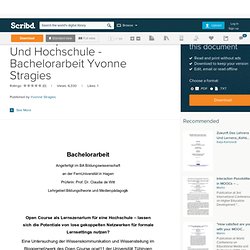

Ocwl11 Open Course Und Hochschule - Bachelorarbeit Yvonne Stragies. Inhaltsverzeichnis Inhaltsverzeichnis ...............................................................................................................

I Tabellenverzeichnis .......................................................................................................... III Abbildungsverzeichnis ...................................................................................................... Abkürzungsverzeichnis..................................................................................................... Einleitung ................................................................................................................... 1 Begriffsdefinitionen ..................................................................................................... 4 Social Software .................................................................................................... 5 Gruppen, Communities und Netzwerke ............................................................. 10.
Lecture2go.uni-hamburg.de - Konferenzen. Top Ed-Tech Trends of 2012: MOOCs. Part 5 of my Top Ed-Tech Trends of 2012 series The Year of the MOOC Massive Open Online Courses.

MOOCs. This was, without a doubt, the most important and talked-about trend in education technology this year. And oh man, did we talk about it. In retrospect, it’s not surprising that 2012 was dominated by MOOCs as the trend started to really pick up in late 2011 with the huge enrollment in the three computer science courses that Stanford offered for free online during the Fall semester, along with the announcement of MITx in December. Who cares what Cormier thinks and predicts? January: Lecture2go.uni-hamburg.de - Konferenzen. The 'Course' in MOOC. A discussion taking place on the OER-Forum Discussion List.

Posts by other people in italics. Abel Caine wrote, "I have to intervene with the developing country perspective. Millions of smart, motivated children/students for many reasons do not complete regular school or university. Given the opportunity, these learners have a burning desire to 'complete' the course. "Well-designed and smartly-delivered" MOOCs with a valid, transferable certificate of completion (learning experience) may be 1 viable solution. Andy Lane wrote, "Yes participants whether they complete or not can gain from the experience but we also know that many can be adversely affected by the experience through a sense of failure or lack of esteem.
With respect to cMOOCs, the student experience is more like joining a community than working their way through a body of content. Here's why the C in MOOC continues to stand for 'Course'. It's like watching a TV series. John's post has two major objectives. Ask anyone. Designing and Running a MOOC. Creating the Connectivist Course. When George Siemens and I created the first MOOC in 2008 we were not setting out to create a MOOC.

So the form was not something we designed and implemented, at least, not explicitly so. But we had very clear ideas of where we wanted to go, and I would argue that it was those clear ideas that led to the definition of the MOOC as it exists today. There were two major influences. One was the beginning of open online courses. We had both seen them in operation in the past, and had most recently been influenced by Alec Couros’s online graduate course and David Wiley’s wiki-based course. The other major influence was the emergence of massive online conferences. We set up Connectivism and Connective Knowledge 2008 (CCK08) as credit course in Manitoba’s Certificate in Adult Education (CAE), offered by the University of Manitoba.
What made CCK08 different was that we both decided at the outset that it would be designed along explicitly connectivist lines, whatever those were.